Hooked on Draconics, Part 1
Dragons of Tarkir is finally public, so that means it's time for me to do my normal card-by-card design stories. I have enough to tell that I'm going to use two articles to fit it all in. So let's not waste any more precious word count and get to it.
Ambuscade Shaman
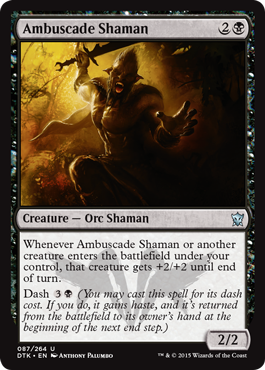
Ambuscade Shaman does a good job of showing off some of the design possible with the dash mechanic. For starters, it has a dash cost higher than its normal mana cost. This is possible because this card manages to both make haste matter more and turn the bouncing into something other than a drawback. If you cast the creature normally, the "enters the battlefield" effect is pretty meaningless. Without haste, the +2/+2 bonus doesn't often have any value (although with things like formidable, it can). With dash though, this ability takes on a new level because the creature can take advantage of the temporary boost by attacking the turn it's cast. The dash ability also lets you constantly repeat the "enters the battlefield" effect, making Ambuscade Shaman essentially a 4/4 when cast with dash.
Cards like this are very important because you want to force players to have to reevaluate things they think they understand at first blush. It gives the game play more depth and it allows for extra discovery as the players start to realize some of the nuance possible with the new mechanic.
THE COMMAND CYCLE
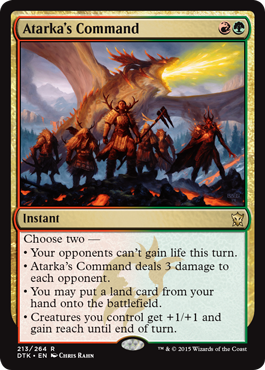
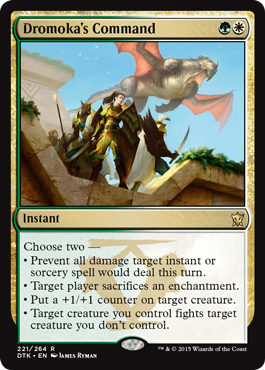
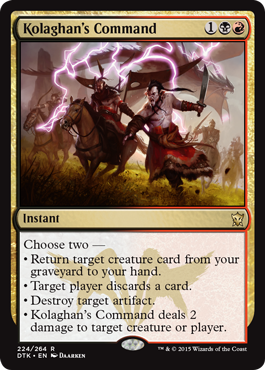
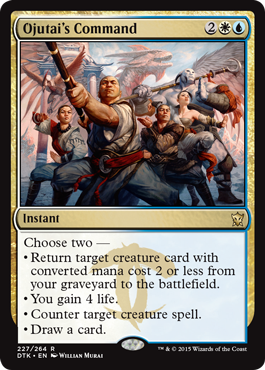
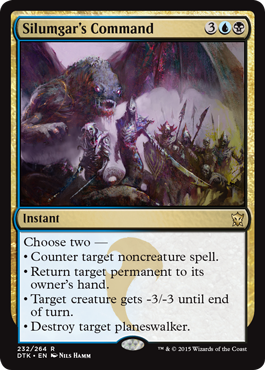
Aaron Forsythe loves choices. On every design team I've worked with him on, he has always found some new way to make a series of cards that give the caster a number of choices when casting them. In Lorwyn, he made a cycle of cards he originally called Super Charms. The original Charms from Mirage were instants that allowed you to choose one of three small effects. The Charms were much beloved and we've done them again and again in many different incarnations. The Super Charms gave you four choices instead of three and let you choose two effects instead of one. The Commands, as they ended up being called, were a huge hit; Cryptic Command, the blue one, became a staple in many formats.
During Khans of Tarkir design, there was a lot of talk about doing three-color Commands. The problem was how do you make cards with four choices when there are three colors? The solution we came up with, as each wedge had a central color, was to let the main color get a second effect. But we knew that the last set was going to be two-color in theme and we'd never made multicolor Commands, so we thought possibly two-color would work better. That would allow two abilities to choose from for each color.
The Dragons of Tarkir design team tried a number of different cycles in this slot, but momentum kept pulling us back to doing Commands. It was just too good a fit to pass up. The five were obviously tied creatively to the five dragonlords.
MONUMENTS
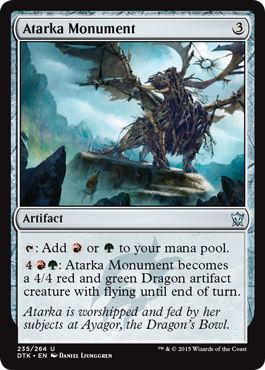
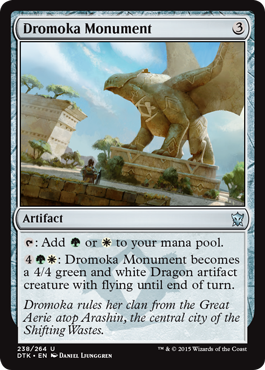
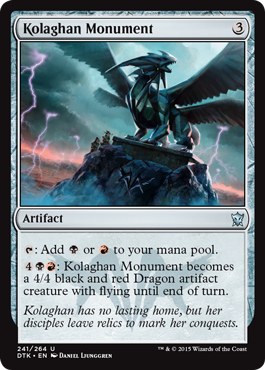

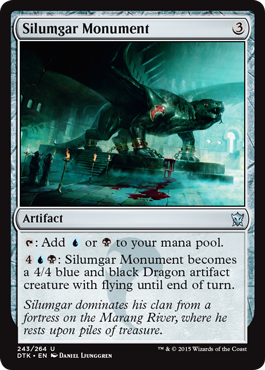
One of the great challenges of Dragons of Tarkir's design was trying to fit as many Dragons in the set as possible. Eventually, we realized that as we stuffed more and more Dragons in, there was just less room for more Dragons. That's when we had to start getting creative. What if we made Dragons that weren't Dragons or, well, at least weren't always Dragons?
The Monument cycle started as an artifact cycle to provide mana. They were just mana stones that tapped for two different colors to help you play your cards. Then the idea was suggested that maybe later in the game these could turn into Dragons. The effect would cost a lot of mana (six mana total, four generic and one of each color) and only last until end of turn, but it would allow players to sneak even more Dragons into their decks.
Aven Sunstriker
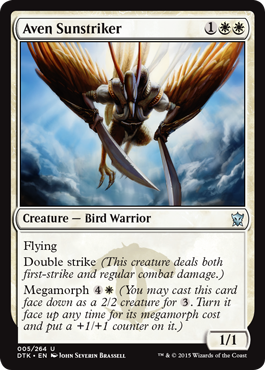
In my preview article, I talked a bit about how we ended up choosing megamorph as the morph variant, but I didn't spend much time talking about how we designed megamorph cards. While they might seem like just a small tweak to morphs, the actual design is a bit different.
First, the +1/+1 counter changes the dynamic between playing the mechanic face up and playing it face down. If you have the mana to play a morph face up, the only thing usually stopping you is a triggered effect when the card gets turned face up. With megamorph, going through the motions makes your creature a little bigger, and that difference is where design tended to focus. Let's take Aven Sunstriker as an example.
A 1/1 flying double striker for 1WW is okay, but the extra +1/+1 counter is a significant upgrade, enough so that you will often cast the creature face down despite how much mana you have available. The +1/+1 counter has added meaning, especially in white and green, because those two colors have a small "+1/+1 counter matters" theme.
CUNNING BREEZEDANCER AND FRIENDS
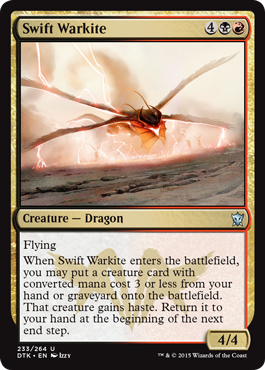
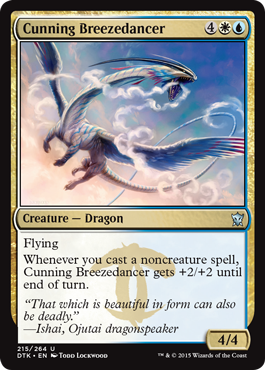
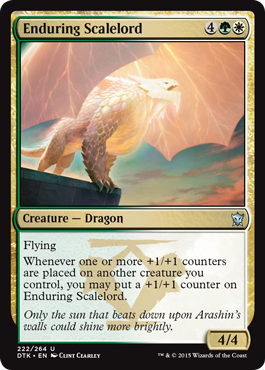
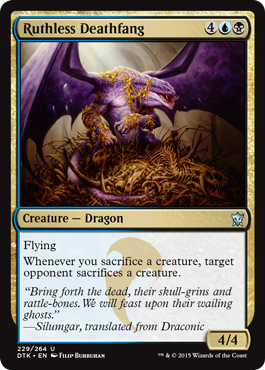
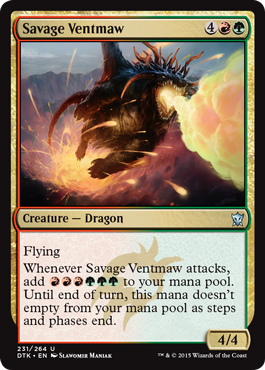
Erik Lauer, the head developer, came up with an idea several years back to use a cycle of two-color spells to help define color pairs in Limited. If you take the card early, it will help steer you to what the color combination is up to. In the beginning, Erik was adding these cards in development, but once we saw the value of them, we started doing them in design. For Dragons of Tarkir, we asked, "What if the uncommon multicolor cycle was Dragons?" We wanted Dragons to be central to the gameplay, so why not use them on a component that was all about messaging?
These Dragons are a looser cycle. Each has an effect central to what its color pair is up to in Limited. The one thing they all have in common is they are all relatively strong in Limited and do a lot to help guide drafters.
Clone Legion
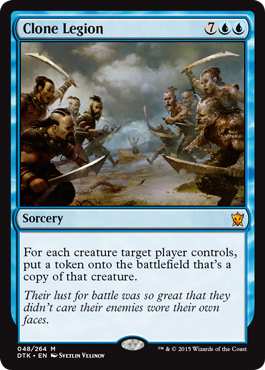
I designed this card using a technique I call "go big." Here's how it works: I'm asked to design a mythic rare. I pick some effect that a color normally uses. I then ask myself, "What is the biggest possible version of this effect we could do?" For example, Lightning Bolt would be "Deal 3 damage to every creature and every player."
The card in question for this technique was Clone, a creature that dates all the way back to Alpha. The obvious answer was, "When this creature enters the battlefield, it is a copy of every creature on the battlefield." Okay, that's a little wonky ruleswise, so I changed it to making token copies. Copying everything was very expensive, so I pulled back a little. What if I just copy everyone else's creatures?
One of the lessons we've learned over the last few years is for us to be careful about making cards that are fine in two-payer games but complete blowouts in multiplayer play, so I changed the ability from copying everyone else's creatures to copying target player's creatures. That way, in a multiplayer game, you have more options but you're not going to be unbeatable.
And that is how Clone Legion came to be.
Commune with Lava
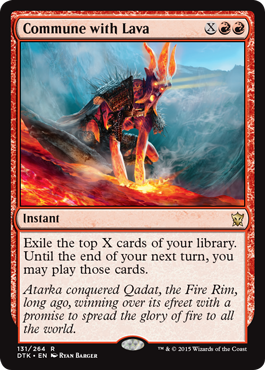
One of the things that making an ongoing game allows us is the chance to constantly improve. Magic is an evolving game, which means we are allowed to keep fiddling with the basic elements and find ways to fix problems as we discover them. One problem Magic has had for a while is the narrowness of red's stable of abilities. Of the five colors, it has the fewest different effects. (Although in red's defense, direct damage is a lot more than just one ability.)
A couple of years ago, we were looking for ways to expand red, and we stumbled upon the idea of letting red have access to more abilities but limiting the duration it has to use them. Red can dip its toe into the effects of other colors but it has to do them more impulsively. Red needs to use the ability now or lose it. This led us to the idea of impulsive drawing. Red can draw cards but it has to cast them this turn. (Red had messed a bit with this mechanic back in the day.)
R&D has been calling this "impulsive draw." We first put it on Chandra, Pyromaster in Magic 2014 and have quickly adopted it as a new tool in red's arsenal. Commune with Lava is us finally getting around to an X version of the spell. To help the player cast the spells, we extended the duration from the end of the current turn to the end of your next turn. This allows you to untap once to get access to mana to cast the spells.
Dragon Fodder

Every once in a while, you're working on a set and you're trying to come up with a new card and then you realize that there's an old card that mechanically does exactly what you need. And then it dawns on you that the name of that card fits perfectly in the set you're working on. So much so that you start to wonder if the card was truly made for this set and was stolen by time-traveling R&D members who took it back to the past and used it, making it look like you copied them.
Dragon Fodder was one such card. We needed a red token maker and when we realized that Dragon Fodder was an option, we were literally giddy. Some giggling might have occurred. There was not a more perfect card for Dragons of Tarkir.
Dragon Hunter

One of the trickiest things to balance is how much a set supports its themes and how much it provides answers to them. Do too little support and players aren't able to build decks around the set's themes. Do too much hate and the themes never get a chance to shine. The best hate cards are not things that shut down players playing the theme but rather that make their lives more difficult.
As an example, let's take a look at Dragon Hunter. Dragons are going to have a hard time killing it, and with reach it can easily block almost any Dragon it wants, but—and this is the important part—having a Dragon Hunter does not shut down a Dragon deck. Yes, it creates some difficulties but not ones that cannot be overcome. Also, note that Dragon Hunter stops Dragons but it isn't particularly efficient at killing Dragons.
DRAGONLORDS
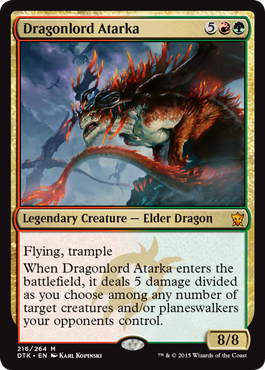

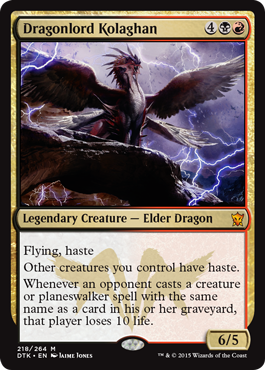
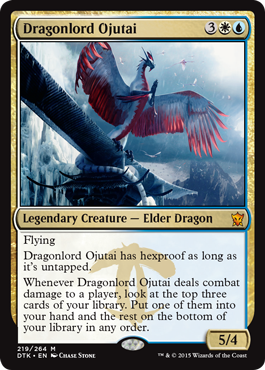
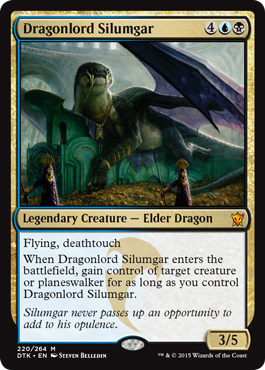
Once we solidified the time-travel structure, we knew the block was going to have the following: five mythic rare legendary creatures in the first set representing the human and humanoid khans; a Planeswalker with two different versions, one in the first set and one in the third set; and five mythic rare legendary Dragons that would be the Dragonlords running the clans. It wasn't until we started thinking about Fate Reforged that we realized that we wanted the legendary Dragons not once, but twice.
Dragons live much longer than 1,200 years, meaning the five Dragons that would rise to power would be alive in the middle set. If we wanted to properly set up the second timeline, it was important to meet them. The problem was, we didn't want the versions in Fate Reforged to upstage the Dragonlord versions in Dragons of Tarkir. The solution was to scale back the Fate Reforged versions. We made them a bit smaller and made them rare rather than mythic rare. This way, we gave ourselves a little space to create impressive versions in the final set.
This was another very loose cycle. Other than the color pairings and a second creature keyword other than flying, each Dragon was designed to be something impressive in the appropriate two-color deck. It was a conscious decision to make the Dragons' designs cool in a vacuum and not require you build a deck around them.
Dragonlord's Prerogative
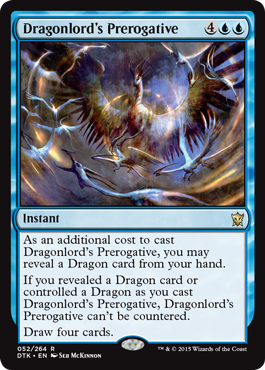
Part of making a "Dragons set" is not just having a lot of Dragons but also finding ways to make Dragons matter. There is a limit to how many Dragons can fit into a set, so we have to be willing to make the Dragons' presence known through other means. Just having the word "Dragon" show up in rules text helps create a sense that Dragons are important.
One way to do this is to have spells that have a benefit if you have a Dragon card in your hand. Dragons are normally expensive, so they spend most of the game in your hand. Having cards like Dragonlord's Prerogative helps you make them relevant even before you cast them. As this card is a little more expensive, we decided that the bonus also worked if you controlled a Dragon on the battlefield. This way, you were not discouraged from casting your Dragons.
Dromoka Dunecaster
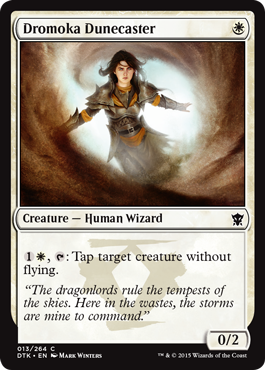
There is yet another way to make Dragons matter and that is to be extra careful how your cards interact with Dragons, especially at common. Dromoka Dunecaster is a very good example. Usually, white has a creature that activates—most often with a cost that requires tapping—to tap creatures. The problem is, a card like this is particularly effective against a Dragon. You pay a lot of mana to cast your Dragon and your opponent pays far less to tap it each turn.
The key to helping Dragons thrive is to be careful about how many effects you allow that are potent against them. You definitely need to have answers to Dragons, but usually those answers are one for one, not super mana efficient, and not repeatable. As such, Dromoka Dunecaster is good at tapping nonfliers. All Dragons fly, so this restriction is a way to keep it from affecting Dragons without having to say so quite so bluntly.
Epic Confrontation (dragon punching)

Once you've punched a bear there's no going back. We knew that, in the alternative timeline, we had to find a cool twist on the bear punch. Interestingly, there was debate on just what that twist was supposed to be. There were three options:
1. A Dragon Punches a Bear
In the Khans of Tarkir timeline, Surrak punched a bear. Well, how do we communicate that the dragons have taken over and are now the leaders of the clans? Well, what if we had them do things we saw the khans do?
2. A Bear Punches Surrak
It's possible that the timeline turns events on their ear. Maybe this time, instead of Surrak punching the bear, the bear punches Surrak.
3. Surrak Punches a Dragon
Surrak doesn't put up with stuff in either timeline. Are the dragons in charge? Well, then have Surrak punch a dragon.
Each of the above choices is satisfying in its own way. The problem with the second choice is there's no dragon. It's Dragons of Tarkir, "the Dragon set", filled with Dragonlords. There really had to be a dragon. The first choice left out Surrak and, really, if anyone gets to punch things, I think Surrak is the man to do it. That left us with our third choice and dragon punching it was.
Haven of the Spirit Dragon
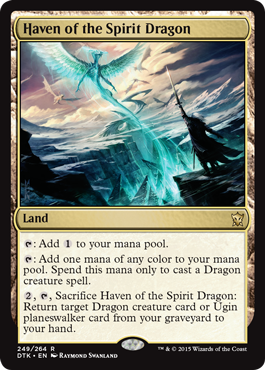
One of the things that often happens in design is wanting to make a land to support the set's themes. Dragons of Tarkir was clearly a "Dragon set," so we wanted a land that helped with Dragons. As Dragons have higher mana costs, the most obvious choice was to provide mana to help cast Dragons. Also, because the Dragons come in all five colors, the land should help you fix colors. The "tap for one colorless" was added to make sure the land has some general usefulness in the early and midgame, before you're able to cast your Dragons.
The card had a little room for something more, so a final piece of the design was added for flavor. When Sarkhan returns to the past, his mission is to save Ugin. If this card represents Ugin's resting spot, then it would be real nice if it could convey a little "save Ugin" flavor. Returning a Dragon from the graveyard to your hand seemed to fit the bill. Just one small problem: Ugin isn't a Dragon, mechanically. Yes, he's one in the story, but as far as the game is concerned he's a Planeswalker, not a Dragon. The solution to this problem was just to add Ugin as an option of something you can save.
"Storytime's Over"
That's all the time I have for today. The fact that I only got through "H" and the column has "Part 1" in its title should hint at the fact that I'm going to continue this next week. But until then, I would be delighted if you gave me feedback on the article or Dragons of Tarkir. You can write to me through my email or any of my social media (Twitter, Tumblr, Google+, and Instagram).
Join me next week for Part 2.
Until then, may you make some of your own stories with Dragons of Tarkir.
"Drive to Work #208—Red/Green"
This podcast is another in my series on two-color pairs.
"Drive to Work #209—Iteration"
This podcast talks about a very important tool of design: the act of iteration. I talk about how we use it in making Magic and how it can be a great boon for any game design.
- Episode 209 Iteration (18.9 MB)
- Episode 208 Red/Green (13.4 MB)
- Episode 207 Design 102 (15.6 MB)
- Episode 206 Arabian Nights, Part 3 (16.7 MB)
- Episode 205 Arabian Nights, Part 2 (18.0 MB)
- Complete Drive To Work Podcast Archive
So You Want to Work at Wizards
Long ago, I talked to someone at Wizards who was complaining about having trouble finding an employee for a job that required a certain amount of Magic knowledge. I told that person I knew where to find tens of thousands of Magic players, many who would love a chance to work at Wizards. That resulted in the first job posting at the end of my column. Well, it's worked out well both for Wizards and for my readers, so the tradition continues.
Today, we're looking for a digital product manager.
The requirements are:
- B.A./B.S. in Business, Marketing, Statistics, Economics, or equivalent degree or work experience
- Knowledge of computer and mobile technology/platforms, distribution/operations models
- Mastery of Word, Excel, PowerPoint, and Outlook required
- 5+ years of direct experience in digital/online Product Management and/or Product Marketing
- Previous experience with a leading digital game/entertainment/service-oriented company strongly preferred
- Previous experience with Magic: The Gathering products a plus
- Understanding of online customer engagement services required
- Strong understanding of the Magic: The Gathering player communities a plus
And asks for the following knowledge, skills, and abilities:
- Practical knowledge of digital product/service/game marketing
- Practical knowledge of project management practices and supporting tools
- Practical knowledge of modern software development practices (Agile, Lean, Scrum, etc.)
- Experience incorporating insightful consumer understanding and analytical data into product/project/service planning and management
- Experience managing complete product/service lifecycles through initiation, launch, updates, maintenance, and end-of-life
- Experience directly leading and influencing cross-functional product/service development and operations teams in a matrixed/diverse organization
- Expertise driving actionable plans aligned to strategic vision and goals
- Capable of prioritizing and handling multiple projects simultaneously, under tight time constraints and within budget parameters
- Excellent communication and presentation skills
- Highly creative, resourceful, and visionary
- Experience working with international partners a plus
- A passion for Magic: The Gathering a huge plus
If you think that sounds like you, see the full job listing here.
There are also a number of other Magic-related jobs posted online, so take a look and see if any of the other openings sound like they'd fit you.

